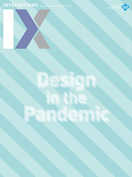Authors:
Montathar Faraon
The worldwide pandemic of coronavirus disease (Covid-19) is testing societies, companies, and citizens. Life, health, and jobs are at stake. In this critical moment, the HCI community is working together to design, test, and execute ideas, prototypes, and solutions. HCI is working to strengthen our resistance with abilities, expertise, and methods to design intuitive solutions that are accessible, understandable, and usable.
The coronavirus disease has had far-reaching consequences for public health, financial markets, and everyday life. With currently over 6 million infected and 370,000 deaths [1], the disease has left few people unaffected by its impact. Technological developments in transportation over the years have contributed to the rapid movement of people and, in turn, to the worldwide spread of the disease. Likewise, researchers, designers, and developers around the world are racing to understand, design, and develop digital technology to trace and mitigate the spread.
Contact tracing, in combination with social, or more appropriately, physical distancing, has been viewed by governments as a useful asset in controlling the spread of the disease. A video produced through a collaboration between Tectonix and X-Mode Social [2], who utilized anonymized location data of mobile devices, showed how far the disease could spread if physical distancing is ignored. Novel ideas for contact tracing are considered essential because, unlike other diseases, Covid-19 appears to spread easily before any symptoms become apparent.
The tools offered by the Singapore government would violate U.S. privacy laws like HIPAA.
One of the early stories concerning contact tracing came out of Singapore. The government managed to curb the spread of the disease through mobile tracking by using a smartphone app called TraceTogether [3]. Through Bluetooth technology, the app tracks users' proximity to other people and alerts those who come in contact with someone who has tested positive. The government also sent daily updates to its citizens that included the current number of cases, suspected areas of outbreaks, and hygiene information to avert infection.
Moscow's local government rolled out a QR code system to allow residents to leave their homes and a smartphone app called Social Monitoring to track patients' movements. Residents need to register on the government's online portal, which requires both a phone number and photo verification. The online portal could then be used to generate a new QR code every time a resident needed to leave their apartment. If stopped by the police, residents would be required to show the QR code.
In the U.S., companies such as Google and Facebook are responding to the pandemic by using mobile location data to aid public health officials in understanding people's movement and to what degree people are following physical distancing recommendations set forth by the government. Google released Community Mobility Reports [4], which provide information about mobility trends in places such as shops, grocers, parks, transit stations, workplaces, and homes. Likewise, Facebook shared mobile location data with academics, as part of its Disease Prevention Maps program, to better understand the success of measures aimed to decrease mobility. Similar to previous initiatives, the Massachusetts Institute of Technology (MIT) has published an app called Private Kit: Safe Paths to notify people if they have likely come into contact with a person who has tested positive for Covid-19.
Because of the different privacy standards around the world, it is difficult to take advantage of and adopt mobile tracking technology between countries. For example, the tools offered by the Singapore government would violate U.S. privacy laws like the Health Insurance Portability and Accountability Act (HIPAA) as well as Europe's General Data Protection Regulation (GDPR).
To address privacy and data-protection concerns, a mobile tracking initiative has been launched in Europe, consisting of 130 members across eight countries. Pan-European Privacy-Preserving Proximity Tracing (PEPP-PT) [5] aims to create an app that takes advantage of Bluetooth signals to detect within certain limits if users may be close enough to infect each other (e.g., closer than 2 meters for more than 15 minutes). Unlike the invasive surveillance technology now being used by governments, the initiative adheres to European privacy and data-protection laws by encrypting and anonymizing personal information.
Mobile-tracking apps could provide more accurate data during a pandemic in order to reduce transmission. They are, however, not without challenges. For instance, enough people must install mobile-tracking apps for them to be useful. Even if 30 to 50 percent of a population installs a mobile-tracking app, it could have a long-term impact. Continuous use of contact tracing through mobile tracking, together with physical distancing, may need to be combined with scaled-up testing and hygiene measures to avoid a resurgence of the disease.
The global HCI community has united to work passionately on initiatives that make use of our devices to combat this pandemic. Across the world, HCI has played an essential role in a series of virtual hackathons in which novel tools are being designed to address the challenges with Covid-19 (HackTheCrisis in Sweden, the MIT Covid-19 Challenge in the U.S., and the pan-EU EUvsVirus). In the end, defeating the disease requires collective efforts to protect ourselves and our loved ones.
1. COVID-19 Dashboard by the Center for Systems Science and Engineering (CSSE) at Johns Hopkins University; https://www.arcgis.com/apps/opsdashboard/index.html#/bda7594740fd40299423467b48e9ecf6
2. https://www.ctvnews.ca/video?clipId=1930561
3. https://gov.sg/article/help-speed-up-contact-tracing-with-tracetogether
4. Google COVID-19 Community Mobility Reports; https://www.google.com/covid19/mobility/
5. Pan-European Privacy-Preserving Proximity Tracing; https://pepp-pt.org
Montathar Faraon is an interaction design researcher with an interest in co-creation, participatory processes, ICTs for democracy, and concept-driven design. He is an assistant professor in the Department of Design at Kristianstad University, Sweden. [email protected]
Copyright held by author. Publication rights licensed to ACM.
The Digital Library is published by the Association for Computing Machinery. Copyright © 2020 ACM, Inc.









Post Comment
No Comments Found